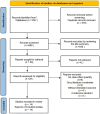Coffee and tea consumption on the risk of osteoporosis: a meta-analysis
- PMID: 40104819
- PMCID: PMC11913691
- DOI: 10.3389/fnut.2025.1559835
Coffee and tea consumption on the risk of osteoporosis: a meta-analysis
Abstract
Objectives: This meta-analysis aims to quantify the relationship between coffee and tea consumption and the risk of osteoporosis and explore whether such consumption positively or negatively impacts this risk, thereby providing a scientific basis for understanding the effects of coffee and tea on bone health.
Methods: We systematically searched PubMed, the Cochrane Library, and Embase for observational studies published up to November 5, 2024, using medical subject headings (MeSH) and keywords related to "osteoporosis, tea, and coffee." Statistical analyses were conducted using Stata software version 14.0. A fixed-effects model was used when heterogeneity was low (I 2 ≤ 50% and p > 0.1). A random-effects model was used for greater heterogeneity (I 2 > 50%). Publication bias was assessed using funnel plots and Egger's regression tests.
Results: This meta-analysis included 14 observational studies comprising 562,838 participants published between 2008 and 2024. The pooled analysis showed that coffee consumption is significantly associated with a reduced risk of osteoporosis (odds ratio [OR] = 0.79, 95% confidence interval [CI]: 0.73-0.84, I 2 = 28.9%, p < 0.05). Tea consumption also demonstrated a protective effect, with a lower risk of osteoporosis (OR = 0.75, 95% CI: 0.62-0.91, I 2 = 80.4%, p < 0.05). Subgroup analysis revealed that high-frequency coffee consumption (more than one cup per day) was associated with a greater reduction in osteoporosis risk (OR = 0.83, 95% CI: 0.74-0.93, p = 0.001) compared to low-frequency consumption (less than one cup per day), which showed no statistically significant reduction (OR = 0.86, 95% CI: 0.68-1.07, p = 0.171). Similarly, high-frequency tea consumption (more than four times per week) exhibited a slightly stronger protective effect against osteoporosis compared to low-frequency consumption (OR = 0.82, 95% CI: 0.70-0.97, p = 0.02).
Conclusion: This meta-analysis suggests that long-term coffee and tea consumption is associated with a reduced risk of osteoporosis. Moreover, a higher frequency of consumption within a moderate range appeared to enhance the protective effect against osteoporosis.
Systematic review registration: https://www.crd.york.ac.uk/prospero/display_record.php?ID=CRD42024612101, PROSPERO CRD42024612101.
Keywords: coffee consumption; meta-analysis; osteoporosis; risk; tea consumption.
Copyright © 2025 Li, Xie and Jiang.
Conflict of interest statement
The authors declare that the research was conducted in the absence of any commercial or financial relationships that could be construed as a potential conflict of interest.
Figures






Similar articles
-
Caffeine, Coffee, Tea and Risk of Rheumatoid Arthritis: Systematic Review and Dose-Response Meta-analysis of Prospective Cohort Studies.Front Nutr. 2022 Feb 10;9:822557. doi: 10.3389/fnut.2022.822557. eCollection 2022. Front Nutr. 2022. PMID: 35223954 Free PMC article.
-
Association of Coffee and Tea Intake with Bone Mineral Density and Hip Fracture: A Meta-Analysis.Medicina (Kaunas). 2023 Jun 20;59(6):1177. doi: 10.3390/medicina59061177. Medicina (Kaunas). 2023. PMID: 37374383 Free PMC article. Review.
-
Tea intake or consumption and the risk of dementia: a meta-analysis of prospective cohort studies.PeerJ. 2023 Jul 18;11:e15688. doi: 10.7717/peerj.15688. eCollection 2023. PeerJ. 2023. PMID: 37483967 Free PMC article.
-
Schizophrenia and type 2 diabetes risk: a systematic review and meta-analysis.Front Endocrinol (Lausanne). 2024 Sep 11;15:1395771. doi: 10.3389/fendo.2024.1395771. eCollection 2024. Front Endocrinol (Lausanne). 2024. PMID: 39324122 Free PMC article.
-
The association of coffee consumption with the risk of osteoporosis and fractures: a systematic review and meta-analysis.Osteoporos Int. 2022 Sep;33(9):1871-1893. doi: 10.1007/s00198-022-06399-7. Epub 2022 Apr 15. Osteoporos Int. 2022. PMID: 35426508
Cited by
-
The role of fat-soluble vitamins on bone metabolism and osteoporosis: a literature review.Ann Med. 2025 Dec;57(1):2533429. doi: 10.1080/07853890.2025.2533429. Epub 2025 Jul 20. Ann Med. 2025. PMID: 40684309 Free PMC article. Review.
-
Beverage consumption on bone and joint disorders: an umbrella review.J Glob Health. 2025 Aug 4;15:04222. doi: 10.7189/jogh.15.04222. J Glob Health. 2025. PMID: 40755011 Free PMC article.
-
Comparison of short- and long-term efficacy and economic indicators between transabdominal preperitoneal and open tension-free repair for inguinal hernia in adults: a meta-analysis of randomized controlled trials.Hernia. 2025 Aug 7;29(1):248. doi: 10.1007/s10029-025-03435-3. Hernia. 2025. PMID: 40773057 No abstract available.
References
Publication types
LinkOut - more resources
Full Text Sources

